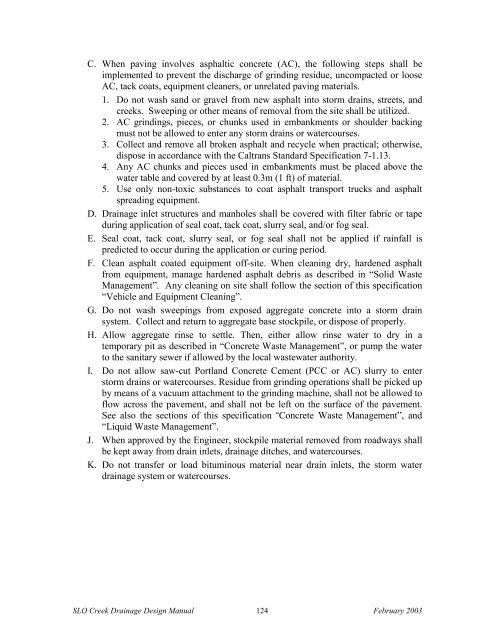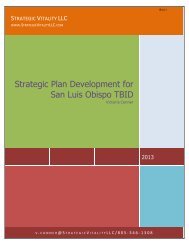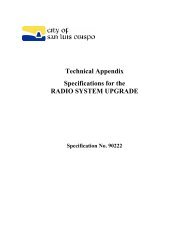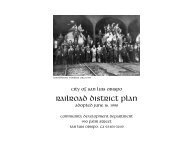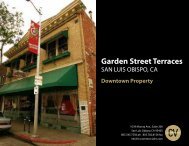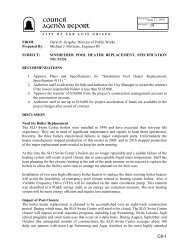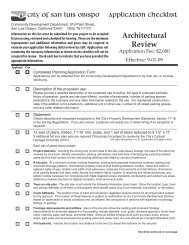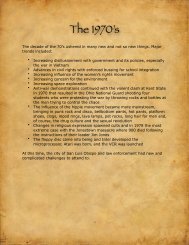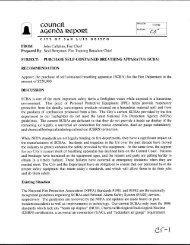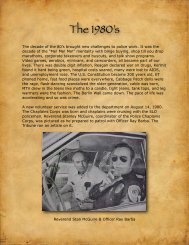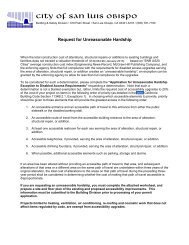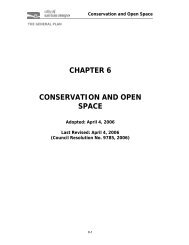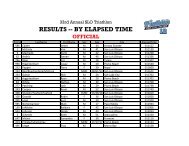Drainage Design Manual - the City of San Luis Obispo
Drainage Design Manual - the City of San Luis Obispo
Drainage Design Manual - the City of San Luis Obispo
Create successful ePaper yourself
Turn your PDF publications into a flip-book with our unique Google optimized e-Paper software.
C. When paving involves asphaltic concrete (AC), <strong>the</strong> following steps shall beimplemented to prevent <strong>the</strong> discharge <strong>of</strong> grinding residue, uncompacted or looseAC, tack coats, equipment cleaners, or unrelated paving materials.1. Do not wash sand or gravel from new asphalt into storm drains, streets, andcreeks. Sweeping or o<strong>the</strong>r means <strong>of</strong> removal from <strong>the</strong> site shall be utilized.2. AC grindings, pieces, or chunks used in embankments or shoulder backingmust not be allowed to enter any storm drains or watercourses.3. Collect and remove all broken asphalt and recycle when practical; o<strong>the</strong>rwise,dispose in accordance with <strong>the</strong> Caltrans Standard Specification 7-1.13.4. Any AC chunks and pieces used in embankments must be placed above <strong>the</strong>water table and covered by at least 0.3m (1 ft) <strong>of</strong> material.5. Use only non-toxic substances to coat asphalt transport trucks and asphaltspreading equipment.D. <strong>Drainage</strong> inlet structures and manholes shall be covered with filter fabric or tapeduring application <strong>of</strong> seal coat, tack coat, slurry seal, and/or fog seal.E. Seal coat, tack coat, slurry seal, or fog seal shall not be applied if rainfall ispredicted to occur during <strong>the</strong> application or curing period.F. Clean asphalt coated equipment <strong>of</strong>f-site. When cleaning dry, hardened asphaltfrom equipment, manage hardened asphalt debris as described in “Solid WasteManagement”. Any cleaning on site shall follow <strong>the</strong> section <strong>of</strong> this specification“Vehicle and Equipment Cleaning”.G. Do not wash sweepings from exposed aggregate concrete into a storm drainsystem. Collect and return to aggregate base stockpile, or dispose <strong>of</strong> properly.H. Allow aggregate rinse to settle. Then, ei<strong>the</strong>r allow rinse water to dry in atemporary pit as described in “Concrete Waste Management”, or pump <strong>the</strong> waterto <strong>the</strong> sanitary sewer if allowed by <strong>the</strong> local wastewater authority.I. Do not allow saw-cut Portland Concrete Cement (PCC or AC) slurry to enterstorm drains or watercourses. Residue from grinding operations shall be picked upby means <strong>of</strong> a vacuum attachment to <strong>the</strong> grinding machine, shall not be allowed t<strong>of</strong>low across <strong>the</strong> pavement, and shall not be left on <strong>the</strong> surface <strong>of</strong> <strong>the</strong> pavement.See also <strong>the</strong> sections <strong>of</strong> this specification “Concrete Waste Management”, and“Liquid Waste Management”.J. When approved by <strong>the</strong> Engineer, stockpile material removed from roadways shallbe kept away from drain inlets, drainage ditches, and watercourses.K. Do not transfer or load bituminous material near drain inlets, <strong>the</strong> storm waterdrainage system or watercourses.SLO Creek <strong>Drainage</strong> <strong>Design</strong> <strong>Manual</strong> 124 February 2003


